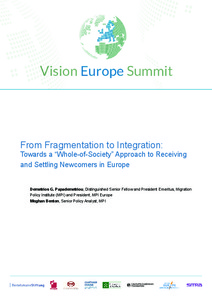From fragmentation to integration. Towards a “whole-of-society” approach to receiving and settling newcomers in Europe
"European societies are facing the challenge to integrate large numbers of migrant having arrived in the midst of what has been labelled refugee crisis. The lessons of history suggest that newcomers’ integration into Europe’s labour markets – and communities – will be neither straightforward no...
| Main Authors: | , , |
|---|---|
| Institution: | ETUI-European Trade Union Institute |
| Format: | TEXT |
| Language: | English |
| Published: |
Gütersloh
2016
Bertelsmann Stiftung |
| Subjects: | |
| Online Access: | https://www.labourline.org/KENTIKA-014612483289-From-fragmentation-to-integrat.htm |
| Summary: | "European societies are facing the challenge to integrate large numbers of migrant having arrived in the midst of what has been labelled refugee crisis. The lessons of history suggest that newcomers’ integration into Europe’s labour markets – and communities – will be neither straightforward nor complete. Although some groups have performed remarkably well, the general story across the continent is one of persistent socioeconomic gaps between natives and newcomers. There is also considerable evidence that this disadvantage is often passed on to children, making EU member states less successful than other OECD countries in supporting intergenerational mobility. Meanwhile, the concentration of migrant and minority groups in housing, schools and services continues to fuel anxiety about immigration and various forms of discrimination. Together, these factors create a vicious cycle that makes it harder for newcomers and their offspring to thrive.
The prognosis for the most recent cohorts of newcomers in most, though not all, cases is therefore not immediately positive. While it is true that an increasing share of well-educated newcomers is entering the workforce, most new arrivals possess characteristics routinely associated with difficulty entering and succeeding in the labour market: limited education, poor host country language proficiency, and skills and experience out of sync with the needs of local employers. The diversity and scale of inflows, large numbers of unaccompanied minors, and significant health (specifically mental health) needs of newcomers is putting further pressure on already-stretched public services.
However, there is also some good news. Many countries in Europe are old hands at the integration game, and the region can draw from rich collective experience and intelligence on what works. Policymakers who are able to make strategic, far-sighted investments, to balance experimentation and new methods with a rigorous commitment to evaluating what works, to enlist new actors (especially employers and other social partners) in supporting immigrant integration, and to avail themselves of new technologies and innovation will be on strong footing to transform this crisis into an opportunity.
The political, social and economic context in European countries is very diverse, as is each country’s immigration history. What works in one country may not work in another. But a number of overarching principles can be identified, which should stand European countries in good stead not just for the persistent effects of this challenge, but the next one. Promising approaches to integration policy are the following:
1. Work-focused but not myopic: prioritising labour market integration, but not at the expense of broader social belonging; for instance, by creating opportunities for people unable to work to nonetheless become full members of new societies;
2. Pre-emptive: taking the earliest opportunity to map the skills – and diagnose the needs – of newcomers and put them on fast tracks to work and inclusion;
3. Coordinated: promoting collaboration and action across the whole-of-government, including brokering a fair deal with local actors and ensuring integration objectives are embedded across all policy portfolios;
4. Collective: bringing together existing civil society groups with new players, from tech companies, to social enterprises, to refugees and migrants themselves, as part of a whole-of-society approach; and
5. Strategic: embedding integration in robust immigration systems that attract and maintain the confidence of the public by selecting the majority of new arrivals.
Integration is no longer a peripheral policy area, if it ever was. But more than any time in the past, it is at the forefront of the minds of Europe’s policymakers. Many of the structural adaptations needed to turn this crisis into an opportunity will benefit everyone. But to truly make this work, everyone has to play their part. The decisions being made now will shape not only the integration outcomes for the most recent newcomers, but the whole way we experience integration in the decades to come. As superdiversity and hypermobility become the water in which we all swim, countries will have to develop truly dynamic responses. Community robustness and resilience may well become the guiding ethos for a more inclusive, yet realistic, future." |
|---|---|
| Physical Description: | 45 p. Digital |

